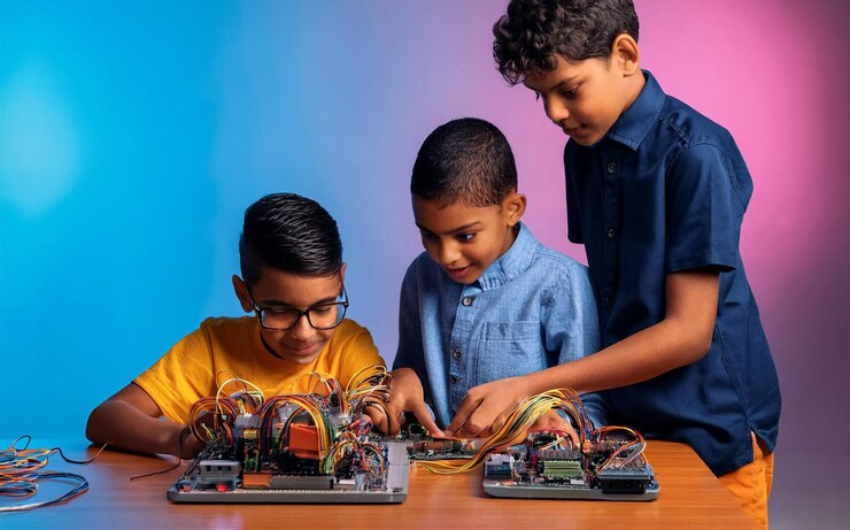Robotics in Education: Burden or Opportunity for Children?
Technology plays a more prominent role in shaping our future in today’s fast-paced world. Robotics, a field once considered highly technical and exclusive, is now becoming a part of school curriculums and extracurricular activities. While many parents and educators see robotics as an exciting and valuable learning tool, a common concern arises—Will learning robotics add more pressure on children?
The response isn’t straightforward; it hinges on how educators and parents introduce, teach, and view robotics. Let’s dive deeper into the discussion to understand whether robotics is an added burden or an opportunity for children to grow.
Understanding Robotics Education for Children
Robotics education isn’t just about building machines; it’s about nurturing creativity, problem-solving skills, and logical thinking. Robotics combines science, technology, engineering, and mathematics (STEM) in an engaging and hands-on way.
When introduced correctly, robotics can feel less like a “subject” and more like an enjoyable activity. Children get to experiment, build models, and see their ideas come to life through working robots. For many kids, this process feels more like play than study.
However, if robotics is forced upon children as an obligation rather than a fun exploration, it can become an added stressor. Like any other subject, the key lies in balance and approach.
Benefits of Learning Robotics for Children
- Boosts Problem-Solving Skills
Robotics challenges children to think critically and find solutions to technical problems. Whether fixing a malfunctioning motor or programming a robot to follow a specific path, children learn resilience and persistence.
- Encourages Creativity
Robotics is not just about following instructions—it’s about innovation. Children are encouraged to think outside the box, design unique robots, and invent solutions for real-world problems.
- Prepares Kids for the Future Job Market
With automation and AI transforming industries, skills in robotics will give children a competitive edge in the future workforce.
- Enhances Teamwork and Collaboration
Many robotics projects involve group activities where children must collaborate, share responsibilities, and collaborate effectively.
The Pressure Factor: Where Does It Come From?
Pressure in learning robotics doesn’t stem from the subject but rather from how it is presented. Here are some common sources of pressure:
- Unrealistic Expectations: When parents or educators expect children to excel immediately, it creates unnecessary stress.
- Competitive Environment: While competitions can motivate, overly competitive atmospheres can overwhelm children.
- Lack of Proper Guidance: If children aren’t given the right resources, mentors, or training, they might find robotics frustrating instead of fun.
- Time Constraints: Adding robotics to an already packed academic schedule can exhaust children.
How to Ensure Robotics Remains Fun and Educational
- Make Learning Playful
Robotics should be treated as an exploration rather than another subject for earning marks. Let children experiment freely without fear of failure.
- Focus on the Process, Not Just Results
The joy of robotics comes from building and problem-solving. Encourage children to enjoy the journey instead of stressing over perfect outcomes.
- Choose Age-Appropriate Programs
Not all robotics programs are suitable for every age group. Ensure the curriculum aligns with your child’s developmental stage.
- Provide Proper Support and Mentorship
A supportive mentor can make all the difference. Children should have access to someone who can guide them patiently and inspire them to keep going.
- Balance is Key
Ensure that robotics doesn’t replace playtime, outdoor activities, or relaxation. A well-rounded routine prevents burnout.
Robotics: A Pressure or a Passion?
At its core, robotics is an exciting and creative field. When introduced correctly, it can spark curiosity, build confidence, and equip children with skills for the future.
However, like any other activity, the key is moderation and support. Robotics should be about learning, experimenting, and having fun—not meeting high-pressure expectations or rigid targets.
Parents and educators have a crucial role in creating an environment that empowers children to grow at their own pace, celebrate each achievement, no matter how small, and relish the learning process.
In conclusion, robotics in education doesn’t inherently add pressure on children—it’s how we present it that determines whether it becomes a burden or a doorway to discovery. With the right approach, robotics can become a powerful tool for building a child’s confidence, creativity, and future readiness.



Alex Johnson
February 20, 2025Great blog! I believe robotics in education helps kids build valuable skills while making learning more engaging.